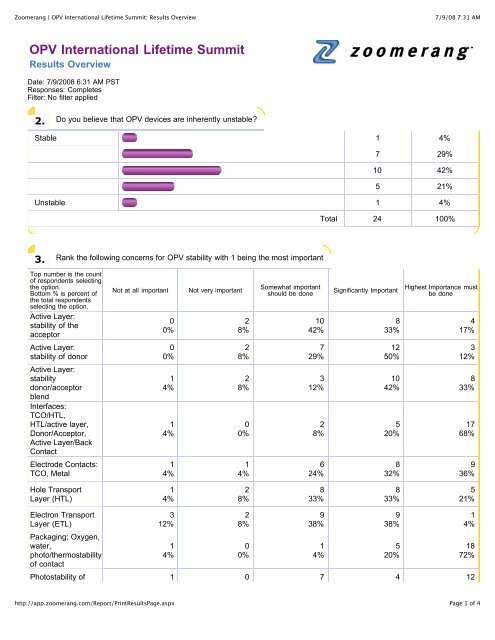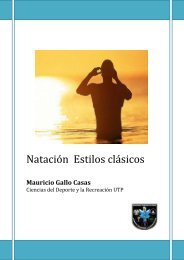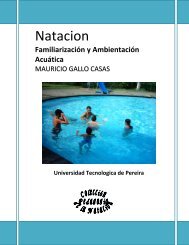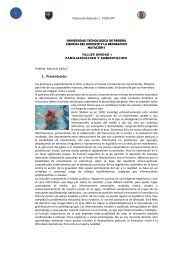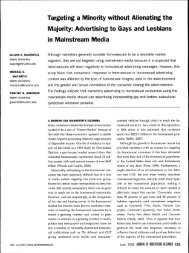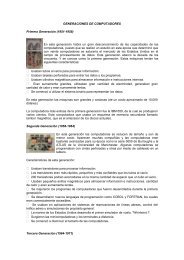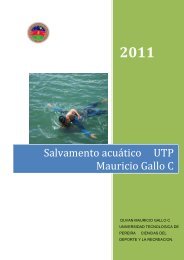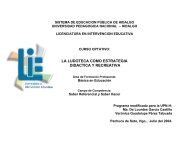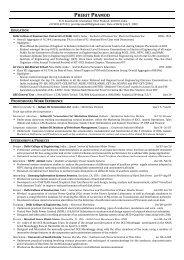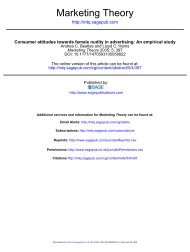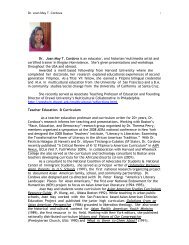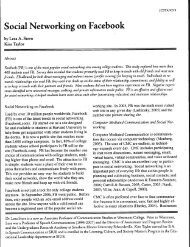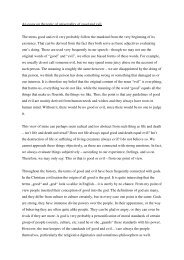Zoomerang | OPV International Lifetime Summit Results Overview
Zoomerang | OPV International Lifetime Summit Results Overview
Zoomerang | OPV International Lifetime Summit Results Overview
You also want an ePaper? Increase the reach of your titles
YUMPU automatically turns print PDFs into web optimized ePapers that Google loves.
<strong>Zoomerang</strong> | <strong>OPV</strong> <strong>International</strong> <strong>Lifetime</strong> <strong>Summit</strong>: <strong>Results</strong> <strong>Overview</strong><br />
<strong>OPV</strong> <strong>International</strong> <strong>Lifetime</strong> <strong>Summit</strong><br />
<strong>Results</strong> <strong>Overview</strong><br />
Date: 7/9/2008 6:31 AM PST<br />
Responses: Completes<br />
Filter: No filter applied<br />
2.<br />
Do you believe that <strong>OPV</strong> devices are inherently unstable?<br />
Stable 1 4%<br />
http://app.zoomerang.com/Report/Print<strong>Results</strong>Page.aspx<br />
7 29%<br />
10 42%<br />
5 21%<br />
Unstable 1 4%<br />
3.<br />
Rank the following concerns for <strong>OPV</strong> stability with 1 being the most important<br />
Top number is the count<br />
of respondents selecting<br />
the option.<br />
Bottom % is percent of<br />
the total respondents<br />
selecting the option.<br />
Active Layer:<br />
stability of the<br />
acceptor<br />
Active Layer:<br />
stability of donor<br />
Active Layer:<br />
stability<br />
donor/acceptor<br />
blend<br />
Interfaces:<br />
TCO/HTL,<br />
HTL/active layer,<br />
Donor/Acceptor,<br />
Active Layer/Back<br />
Contact<br />
Electrode Contacts:<br />
TCO, Metal<br />
Hole Transport<br />
Layer (HTL)<br />
Electron Transport<br />
Layer (ETL)<br />
Packaging; Oxygen,<br />
water,<br />
photo/thermostability<br />
of contact<br />
Not at all important Not very important<br />
0<br />
0%<br />
0<br />
0%<br />
1<br />
4%<br />
1<br />
4%<br />
1<br />
4%<br />
1<br />
4%<br />
3<br />
12%<br />
1<br />
4%<br />
2<br />
8%<br />
2<br />
8%<br />
2<br />
8%<br />
0<br />
0%<br />
1<br />
4%<br />
2<br />
8%<br />
2<br />
8%<br />
0<br />
0%<br />
Somewhat important<br />
should be done<br />
10<br />
42%<br />
7<br />
29%<br />
3<br />
12%<br />
2<br />
8%<br />
6<br />
24%<br />
8<br />
33%<br />
Total 24 100%<br />
Significantly Important<br />
8<br />
33%<br />
12<br />
50%<br />
10<br />
42%<br />
5<br />
20%<br />
8<br />
32%<br />
8<br />
33%<br />
7/9/08 7:31 AM<br />
Highest Importance must<br />
be done<br />
Photostability of 1 0 7 4 12<br />
9<br />
38%<br />
1<br />
4%<br />
9<br />
38%<br />
5<br />
20%<br />
4<br />
17%<br />
3<br />
12%<br />
8<br />
33%<br />
17<br />
68%<br />
9<br />
36%<br />
5<br />
21%<br />
1<br />
4%<br />
18<br />
72%<br />
Page 1 of 4
<strong>Zoomerang</strong> | <strong>OPV</strong> <strong>International</strong> <strong>Lifetime</strong> <strong>Summit</strong>: <strong>Results</strong> <strong>Overview</strong><br />
http://app.zoomerang.com/Report/Print<strong>Results</strong>Page.aspx<br />
7/9/08 7:31 AM<br />
<strong>OPV</strong> active layers 4% 0% 29% 17% 50%<br />
Temperature<br />
Illumination source<br />
type/spectrum<br />
Pattern of<br />
Illumination,<br />
cycling/intermittency<br />
Applied Load<br />
5.<br />
0<br />
0%<br />
0<br />
0%<br />
0<br />
0%<br />
0<br />
0%<br />
3<br />
12%<br />
5<br />
22%<br />
8<br />
35%<br />
5<br />
21%<br />
How stable do you believe current encapsulated <strong>OPV</strong> devices are?<br />
100 hours 2 9%<br />
500 hours 1 4%<br />
1000 hours 9 39%<br />
5000 hours 7 30%<br />
10,000 hours 4 17%<br />
7<br />
29%<br />
11<br />
48%<br />
9<br />
39%<br />
15<br />
62%<br />
9<br />
38%<br />
6<br />
26%<br />
6<br />
26%<br />
2<br />
8%<br />
Total 23 100%<br />
6. To your knowledge do any meaningful and appropriate standards currently exist for <strong>OPV</strong> stability/lifetime?<br />
none 6 25%<br />
initial stages 13 54%<br />
developed 1 4%<br />
adequate 2 8%<br />
well developed 2 8%<br />
8.<br />
What metrics do you believe should be incorporated into the standards for <strong>OPV</strong> stability?<br />
Top number is the count<br />
of respondents selecting<br />
the option.<br />
Bottom % is percent of<br />
the total respondents<br />
selecting the option.<br />
Degree of lost<br />
efficiency (where<br />
should the start<br />
point in efficiency<br />
be?)<br />
Time over which a<br />
device is measured<br />
(is there a<br />
Total 24 100%<br />
least important 2 3 4 most important<br />
1<br />
4%<br />
0<br />
0%<br />
0<br />
0%<br />
0<br />
0%<br />
4<br />
17%<br />
5<br />
22%<br />
5<br />
21%<br />
10<br />
43%<br />
5<br />
21%<br />
1<br />
4%<br />
0<br />
0%<br />
2<br />
8%<br />
14<br />
58%<br />
8<br />
35%<br />
Page 2 of 4
<strong>Zoomerang</strong> | <strong>OPV</strong> <strong>International</strong> <strong>Lifetime</strong> <strong>Summit</strong>: <strong>Results</strong> <strong>Overview</strong><br />
minimum?)<br />
Temperature<br />
Relative Humidity<br />
Light Intensity<br />
Spectrum<br />
Constant<br />
Illumination<br />
Devices kept under<br />
a specific load<br />
Outdoor<br />
Measurement<br />
0<br />
0%<br />
1<br />
4%<br />
0<br />
0%<br />
0<br />
0%<br />
1<br />
4%<br />
0<br />
0%<br />
0<br />
0%<br />
http://app.zoomerang.com/Report/Print<strong>Results</strong>Page.aspx<br />
0<br />
0%<br />
0<br />
0%<br />
0<br />
0%<br />
3<br />
14%<br />
2<br />
9%<br />
2<br />
9%<br />
2<br />
9%<br />
13 Responses<br />
6<br />
25%<br />
3<br />
12%<br />
5<br />
21%<br />
3<br />
14%<br />
6<br />
26%<br />
8<br />
36%<br />
5<br />
23%<br />
9. Should a round robin validation using stabilized and identical devices be done?<br />
Not Necessary 2 8%<br />
8<br />
33%<br />
7<br />
29%<br />
10<br />
42%<br />
11<br />
50%<br />
12<br />
52%<br />
10<br />
45%<br />
7<br />
32%<br />
2 8%<br />
3 12%<br />
10 40%<br />
Mandatory 8 32%<br />
10.<br />
Which techniques are the most important for determining diffusion rates for encapsulation?<br />
Top number is the count<br />
of respondents selecting<br />
the option.<br />
Bottom % is percent of<br />
the total respondents<br />
selecting the option.<br />
Mocon<br />
Ca diffusion<br />
Inference from<br />
encapsulated device<br />
stability vs 'glove<br />
box' devices<br />
Mass-spectrometry<br />
Radioactive method<br />
Total 25 100%<br />
Not very useful 2 3 4 Very useful<br />
1<br />
6%<br />
0<br />
0%<br />
2<br />
11%<br />
0<br />
0%<br />
0<br />
0%<br />
2<br />
13%<br />
2<br />
11%<br />
3<br />
19%<br />
7<br />
44%<br />
2<br />
13%<br />
1<br />
6%<br />
8<br />
50%<br />
4<br />
25%<br />
7<br />
47%<br />
8<br />
44%<br />
2<br />
12%<br />
7/9/08 7:31 AM<br />
10<br />
42%<br />
13<br />
54%<br />
9<br />
38%<br />
5<br />
23%<br />
2<br />
9%<br />
2<br />
9%<br />
8<br />
36%<br />
4<br />
25%<br />
4<br />
27%<br />
5<br />
28%<br />
3<br />
19%<br />
1 4 4 2 2<br />
Page 3 of 4
<strong>Zoomerang</strong> | <strong>OPV</strong> <strong>International</strong> <strong>Lifetime</strong> <strong>Summit</strong>: <strong>Results</strong> <strong>Overview</strong><br />
Radioactive method<br />
http://app.zoomerang.com/Report/Print<strong>Results</strong>Page.aspx<br />
7/9/08 7:31 AM<br />
8% 31% 31% 15% 15%<br />
12. Should NREL create a centralized database for sharing stability information?<br />
No 1 4%<br />
1 4%<br />
Maybe 7 28%<br />
6 24%<br />
Yes 10 40%<br />
13.<br />
Would you be willing to contribute to such a database?<br />
Total 25 100%<br />
No 0 0%<br />
1 4%<br />
Depends 11 48%<br />
2 9%<br />
Yes 9 39%<br />
Products & Services | About Us | Support/Help | <strong>Zoomerang</strong> Forums<br />
© 2008 Copyright MarketTools Inc. All Rights Reserved. | Privacy Policy | Terms Of Use<br />
Total 23 100%<br />
Page 4 of 4
Major Concerns (Raw Data)<br />
encapsulant stability - long term yellowing of flexible packaging<br />
Stability of the morphology; contact issues at electrode due to delamination,<br />
diffusion of ions (from e.g. PEDOT) through the layer<br />
Electron transport is the difficult part in organic photovoltaics<br />
Delamination and dark spot formation are major concerns.<br />
Module specific issues: reverse bias testing due to partially shadowing<br />
I believe that the biggest problem facing <strong>OPV</strong> reliability is the lack of detailed<br />
mechanisms for each type of failure. It's difficult to fix something you don't<br />
understand.<br />
Moisture & O2 permeation<br />
Differentiate between intrinsic and extrinsic effects. For conventional Si<br />
technology, intrinsic issues do not play an important role over the live of the<br />
solar cell. The Si wafer is stable. For <strong>OPV</strong>, we need to study both intrinsic<br />
and extrinsic stability<br />
Other issues are: effect of shadowing, reverse bias, wind, hail, salt, sand,<br />
thermal cycles, connection with balance of system.<br />
Perhaps also discuss the application area, since the stability requirements<br />
depend on the application (consumer electronics, telecommunication,<br />
camping equipement, stand alone PV systems, grid connected & building<br />
integrated PV systems, large scale power plants)<br />
UV stability. Reliance on the packaging to solve stability problems when<br />
experience has shown that samples must be moisture insensitive.<br />
film morphology and device architecture, e.g., transparent and tandem <strong>OPV</strong><br />
devices<br />
The uniformity of the <strong>OPV</strong> active layers and how the interaction of the layers<br />
affect each layers stability<br />
Morphology of donor/acceptor blends; integrity of donor and acceptor phase<br />
and interface<br />
What Standards Exist?
As a starting point the standards from silicon and thin film devices are<br />
being applied (85/85). I do not believe they are meaningful as there is no<br />
data to indicate that the acceleration factors from these other technologies<br />
will be at all applicable. Furthermore, it is not clear that these are the<br />
most important root cause of degradation in <strong>OPV</strong>.<br />
1 sun intensity and 80 degrees. conditions should be either Jcs, Voc, or<br />
maximum power point.<br />
Some measure is desperately needed. perhaps several levels of testing. A<br />
short test that can be useful for screening materials and a longer one that<br />
should be viewed as the real litmus test for stability. The most recent issue<br />
of SOLMAT has some papers detailing stability and methods. Most notably<br />
accelerated testing is not a reliable method<br />
some tests derived from IEC protocols for x-Si are carried out. If these are<br />
adequate depends totally on the foreseen type of applications<br />
Why not use the standards that have been developed for amorphous<br />
silicon?<br />
At the moment people select isolated tests from existing IEC standards to<br />
identify critical stress factors. Some parties are starting to develop prenormative<br />
test protocols which fit better to their product (flexible) and final<br />
application (low-tomedium power applications)<br />
<strong>OPV</strong> devices should be held to the same standards as those made from<br />
other more traditional PV materials.<br />
Adapt IEC test. The operating conditions of the product should determine<br />
standards, not the shortcomings of the material.<br />
IEC thin-film qualification test. question 3 was answered if subjected to<br />
85C/85% RH how long will last. Not on shelf at room temperature.Question<br />
6 - IEC test a minimum. Need to understand degradation to determine if<br />
it is enough.<br />
there is no standard yet<br />
ASTM E1171-04<br />
ASTM E2236-05a<br />
IEC61215<br />
they include implicit assumptions about starting technology
Initial NREL guidance but not adequate yet<br />
Degree of Lost Efficiency<br />
It might be reasonable to report the start point as either the starting<br />
efficiency (after encapsulated, if there is any encapsulation) or after the<br />
device efficiency has stabilized (but then this might need to be defined). I<br />
would borrow the level to which a Si or thin film cell is allowed to degrade<br />
in their quoted lifetimes.<br />
with at least a 5 percent device<br />
The degree of loss is important. Do not test this for mediocre devices, only<br />
for those that reach a reasonable (e.g 3% or more) efficiency. Otherwise<br />
you will get the answers to quateuons that are not important.<br />
I don't understand this - why talk about "losing efficiency"?<br />
To make things clear, degree of lost effieciency should always be<br />
mentioned. Importance of starting point: dpeends on application<br />
The value of stable efficiency will be important.<br />
set of data required<br />
scientific model/understanding<br />
deduce, understand & confirm acceleration factors<br />
start with outdoor tests already at initial stage of stability studies<br />
To the point like amorphous silicon. The stabilized efficiency is after an<br />
initial transient.<br />
starting point is "as rated" - in aSi they condition cell first or rate low to<br />
compensate.<br />
Output power under load is most relevant parameter<br />
Minimum Time for Device Measurement
minimum of 500 hours<br />
At least 1000 hrs, but some studies should also be done at 5000 hrs.<br />
As above maybe two layers are needed<br />
one for testing materials<br />
one for testing complete modules/devices for applications<br />
If a sample that is measured twice in succession gives two different<br />
values, the measurement reflects the speed with which the measurement<br />
is completed, and, clearly, is not relevant to real use<br />
People use 1000 hours as a minimum since this is mostly used in current<br />
IEC lifetime tests for PV.<br />
As long as it takes to eliminate hysteresis. if you meant exposed<br />
minimum 100 hrs.<br />
may depend on the application<br />
You need to correlate short aggressive environment with longer term<br />
typical environment so that accelerate testing can be done.<br />
5-10 min<br />
Temperature Standard<br />
Are we trying to develop an accelerated degradation standard, "rooftop"<br />
conditions, or something else?<br />
80 degrees. but at least defined<br />
The stability needs to be measured at a temperature that can predict the<br />
stability under real-use conditions.<br />
Various temperatures are important to determine acceleration factors.<br />
Development of standards should also be based on a scientific basis<br />
Same as conventional flat plate.<br />
85C<br />
65
Humidity Standards<br />
Relative humidity is important, but studies should be done both in<br />
presesnce and absecnce of water vapor<br />
The stability needs to be measured at a humidity that can predict the<br />
stability under real-use conditions.<br />
Extremely important to test quality of encapsulants. This is regarded as<br />
one of the most important test in current PV<br />
Seems to be a significant cause of degradation.<br />
standard testing with encapsulated or as-sold product<br />
Light Intensity<br />
There may be intensity dependent degradation. Changing the intensity<br />
may be a way of changing the acceleration factor.<br />
1 sun<br />
1 sun<br />
The stability needs to be measured at an illumination that can predict the<br />
stability under real-use conditions.<br />
In order to accelerate the number of turnovers, it is wise to go for 1 sun<br />
equivalent illumination<br />
1-sun<br />
standard (STC,AM 1.5G)<br />
100 mW/cm2<br />
Spectrum<br />
There needs to be a systematic study of what frequencies adversely<br />
affect <strong>OPV</strong> devices. This may vary from material to material or even<br />
donor:acceptor system to system. It may be possible that UV<br />
degradation studies can be done independently from a studies with<br />
spectrum that is relatively well matched to the EQE. I would think<br />
continuous lamp spectra would be more meaningful than ones from<br />
lamps with many strong lines.<br />
am1<br />
In my view less important, altough UV may detriorate HTL and oxides<br />
used.
Not particularly important, but the issue is how much, if any, UV should<br />
be filtered by the packaging.<br />
The stability needs to be measured under a spectrum that can predict the<br />
stability under real-use conditions.<br />
Presence of UV in the light source might be important.<br />
UV acceleration minimal. UV light expected to damage polymers.<br />
STC<br />
AM1.5G<br />
Continuous Illumination<br />
There may be some healing effect as observed in a-Si, if the sample is<br />
shuttered periodically.<br />
Yes, to save time.<br />
There are many examples of devices improving with a period in the dark.<br />
It may thus be useful to simulate night/day cycles<br />
The use of constant, instead of intermittent, illumination is likely to be a<br />
matter of convenience.<br />
Yes, to accelerate the number of turnovers<br />
Have to be done for accelerated testing<br />
Loading<br />
Keeping a device under the MPP for most of the time, seems to be the<br />
most reasonable "real-world" condition. It may not matter though.<br />
For sure at maximum power point, but SC and OC conditions are also<br />
intersting as they may help to resolvethe mechanisms<br />
Some devices especially the ZnO devices exhibit a memory effect<br />
whereby the load that the device has experience affects the response.<br />
the load should be stated and is sometimes important in what result that<br />
is obtained<br />
The only operating load of importance is that which gives the maximum<br />
power point in the device.<br />
The bias condition is known to affect degradation rates of many devices;<br />
it is likely that it will be important in at least some <strong>OPV</strong> designs
Only if demonstrated different failures in the dark at Voc versus the light<br />
at Pmax or dark biased to Pmax. Secondary problem as long as so<br />
sensitive to air.<br />
Outdoor measurements<br />
Outdoor measurements will be among the most accessible to many, and<br />
if successful, will be very useful for convincing skeptics without more<br />
rigorous lab testing available.<br />
eventually a necessity<br />
Not very useful scientifically, but nice for demonstration issues<br />
Difficult to use as a standard.<br />
The relevance of test procedures should be verified using outdoor<br />
exposure.<br />
Extermely important to strat with field tests as soon as possible,<br />
offcourse depending on the robustness of the system.<br />
Only after can survive 100 hours of 85% RH/ 85 C.<br />
Encapsulation Measurement Techniques<br />
ellipsometry<br />
Need another rapid meaniful technique that to my knowledge has not<br />
been identified yet.<br />
I have yet to see "stabilized identical devices" in organic PV. Most of<br />
differences in organic PV efficiency may not revealed by "round robin"<br />
since the biggest issue seems to be what do you call the area and was an<br />
aperture used. If round robin on identical devices is to be conducted lets<br />
do one with stable filtered Si reference cells.<br />
Comments for the organizers for the meeting<br />
This is a lot to address in two days (especially if there are close to 100<br />
different opinions at the beginning).<br />
None<br />
Having a database already on hand, with early entries, would facilitate<br />
discussion. That might be difficult to get done in time...
try to invite some people from the fields of lifetime testing x-Si PV and<br />
organic LED<br />
Have you arranged for someone to show up with existing standards that<br />
were developed for a-Si and other technologies? Why should you create<br />
new standards? Why not use existing standards?<br />
In my view there are different separate topics to discuss<br />
- intrinsic stability issues: do we need fundamental understandig of the<br />
degradation mechanisms. How can we do this most efficiently? Maybe<br />
invite somebody from the polyLED/Lighting field who has experience with<br />
this.<br />
- Extrinisc issues: packaging, what are requirements for which<br />
application<br />
- Development of IEC type of standards: For this discussion the<br />
photoactive layer itself is not that important. This should be a more<br />
general discussion. We should talk about development of tests that are<br />
specific for a certain product (flexible vs. rigid) or for specific type of<br />
applications (low power, mdeium power, highpower). It is good to invite<br />
peole who are allready commercializing flexible inorganic PV for charging<br />
applications for instance and how they deal with test standards which are<br />
not existing yet. And invite people from certification labs (for instance<br />
ISE, NREL, TUV, etc) who knows what is needed to come to<br />
standardatization.<br />
stability / lifetime testing is difficult, time consuming and receives only<br />
little attention. In the end it is as important as obtaining high efficiencies.<br />
However, typically, stability papers claiming record values do not receive<br />
as much attention as papers claiming record efficiencies. This is just to<br />
indicate that research in stability does not receive the attention as it<br />
deserves. Perhaps a conserted action could help.<br />
A special session on <strong>OPV</strong> stability at the E-MRS might be a good idea,<br />
similarly at a US conference. However, an update once a year should be<br />
sufficient.<br />
A two track long term research programme on generating (intrinsic and<br />
extrinsic) stability data using measurement protocols could serve a trial<br />
and error method to improve stability. In a different track one could build<br />
up a knowledge base on chem. structure-property&morphology-stability<br />
relation. Hopefully leading to a scientific understanding of processes<br />
influencing device lifetime.<br />
Perhaps a conserted action among institutes/universities/companies<br />
could help to us the limited resources efficiently.<br />
Perhaps Michael Köhl from Fraunhofer could give valuable input from<br />
testing protocols. Also strengthening the relations with other organic
electronic communities maybe helpful.<br />
What would be the killer applications for <strong>OPV</strong><br />
Viable Packaging Options<br />
No entirely my field. I think that imprtant questions still exist, even if<br />
encapsulation would be perfect. My largest concern is the long-term<br />
stability of the morphology and the integretity of the layer stack and its<br />
interfaces.<br />
I think we should develop <strong>OPV</strong>s that do not need<br />
encapsulation/protection against oxygen/water<br />
Thin glass should not be ignored for early implementation.<br />
glass<br />
I think you need to understand the degradation mechanisms and<br />
engineer around them rather than trying to solve the problems with<br />
encapsulation. The encapsulation should give physical protection and<br />
protection from puddles of water, but the devices should be able to<br />
survive small exposures.<br />
The packaging will depend on the application<br />
Don't count on the package to solve stability issues. Cells that degrade<br />
in seconds in air can not be made stable by low cost low temperature<br />
package solutions. At present glass / glass packaging on option that has<br />
a chance of protection.<br />
<strong>OPV</strong> cells sealed with glass may be used as standard reference device


